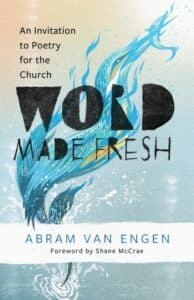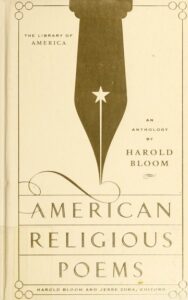
Poetry and religion have much to do with each other, starting with the Bible
A statistic that even people familiar with the Bible find rather startling is that more than half of the Old Testament is poetry. The Psalms are the most obvious, but large parts of the major prophets like Isaiah, Jeremiah and his Lamentations, and Ezekiel are written in poetic form as well. Even the New Testament has poetic sections, including the Sermon on the Mount in the Gospel of Matthew.
But it’s been my own experience — mostly in Protestant denominations but with a not insignificant overlay of Catholicism — that poetry is rarely if ever mentioned within the church context. My own eyes were opened only a decade ago, when I took a weekend seminar with poet Scott Cairns at a writing retreat. That seminar introduced me not only to Cairns’ poetry but also to that of Luci Shaw, Mark Jarman, Dana Gioia, and several others. A door in my mind was suddenly flung open.
Abram Van Engen, Stanley Elkin Professor of Humanities and chairman of the English Department at Washington University, has published a book that I wish he’d written much earlier. Word Made Fresh: An Invitation to Poetry for the Church is exactly what its subtitle says: introducing poetry as a serious component for helping to understand one’s faith and the Bible.

Included as a coda is a short chapter exploring the poem “As Kingfishers Catch Fire” by Gerard Manley Hopkins. Van Engen briefly and succinctly applies what he’s covered in the book. Following that is a helpful discussion guide for both individual and group application.
After reading the Van Engen book, I went looking to see what might be out there more generally, especially in anthology form. I found a rather handsome volume published by the Library of America. American Religious Poems: An Anthology was edited by Yale professor and literary critic Harold Bloom (1930-2019) and published in 2006. Bloom primarily focused on poets with the Judeo-Christian tradition, but he also included those of other religions as well. He even has two concluding sections: American Indian Songs and Chants, and Spirituals and Anonymous Hymns.
Bloom begins with poems from the colonial period, including Roger Williams, Anne Bradstreet, Cotton Mather and others. He moves through the poetry of the early American Republic and then into the 19th century, when the poems (and the poets) become increasingly familiar. Think William Cullen Bryant and “Thanatopsis,” Ralph Waldo Emerson, Henry Wadsworth Longfellow, and even John Quincy Adams (I had no idea he wrote poetry). He adds Thoreau, Herman Melville, Walt Whitman, and Emily Dickinson, among others, and then moves into the late 19th and early 20th centuries. Here he has William Dean Howells, Emma Lazarus, Edith Wharton, W.E.B. DuBois, Paul Laurence Dunbar, and many others.
As Bloom moves through the 20th century, we find Robert Frost, Vachel Lindsay, Wallace Stevens, Kahlil Gibran, Sara Teasdale, Marianne Moore, and Langston Hughes. He continues through poets born in the early 1970s. Some names — Dickinson, Louise Gluck, Scott Cairns, and a few others — are known for at least some of their poems being religious. But many others are not. Bloom is suggesting religion is often more of an influence and inspiration than many of us realize.
Bloom includes this poem by William Stafford (1914-1993):
With My Crowbar Key

careless I dance,
then turn to see
the mark to turn God left for me.
Making my home in vertigo
I pray with my screams
and think with my hair
prehensile in the dark with fear.
When I hear the well bucket strike something soft
far down at noon,
then there’s no place
far enough away to hide my face.
When I see my town over sights of a rifle,
and carved by light
from the lowering sun,
then my old friends darken one by one.
By step and step like a cat toward God
I dedicated walk
but under the house
I realize the kitten’s crouch.
And by night like this I turn and come
to this possible house
which I open, and see
myself at work with this crowbar key.
Like any anthology, American Religious Poems is selective. I would have included Wendell Berry, Luci Shaw, and Dana Gioia at a minimum (they all fall before the cutoff birthdate of the early 1970s).
Another poet I might have included in a religious poetry anthology is John Leax (1943-2024). Prolific in the 1980s to 2015, Leax was a professor of English and poet in residence at Houghton College in New York. Out-of-print now, his books are not easy to find, but Amazon and Alibris both have various editions of his poetry, nature writing, and his one novel, Nightwatch.
His Remembering Jesus: Sonnets and Songs was published in 2014. Based on various verses in the New Testament, the poems amplify or expand the story being told. These include the healing of a leper, the father of the apostles James and John, the rich young ruler who can’t give up his wealth, the dream of the wife of Pontius Pilate, and the raising of Lazarus, among others. Each goes beyond what’s recorded and imagines the person experiencing the events.
This is how Leax interprets the minor events recorded in the Gospel of Mark about Jesus’ crucifixion:
Bystander

Remembering that small particular—
The gesture, at once, strange and familiar—
Perturbs my mind. His face, turned aside, bruised,
And blood-striped, judged our justice, accused
The wanton wielding of law’s hammer
To cross him off the earth. I heard him stammer
A broken sentence; I heard his Word confused.
He succumbed too quickly to satisfy
Our mocking hearts. We watched three men die
Forsaken in the darkened noonday light.
What should that one turning from me occupy
My hours of troubled sleep? Why do I cry
“My God, my God” in the anguished night?
Leax’s poems are more overtly religious than many of the ones found in the Bloom anthology. He first established himself as a poet; even his essay collections often contain poetry. For example, about a third of his essay collection Out Walking (2000) are poems. I find the poems in Remembering Jesus to be moving and quietly provoking.
It may not be featured in the literary magazines, but religious poetry is available and accessible. If an anthology like American Religious Poems is too much, look for the works of any number of contemporary poets — people like Angela Alaimo O’Donnell, Luci Shaw, James Matthew Wilson, Marjorie Maddox Hafer, Dana Gioia, Wendell Berry, Mark Jarman, and others, all of whom have been reviewed and featured here at Tweetspeak Poetry. You will be richly rewarded.
Photo by Pai Shih, Creative Commons, via Flickr. Post by Glynn Young.
Browse more book reviews
How to Read a Poem uses images like the mouse, the hive, the switch (from the Billy Collins poem)—to guide readers into new ways of understanding poems. Anthology included.
“I require all our incoming poetry students—in the MFA I direct—to buy and read this book.”
—Jeanetta Calhoun Mish
- Poets and Poems: Donna Vorreyer and “Unrivered” - October 7, 2025
- Poet Sidney Lanier and the Lost Cause - October 2, 2025
- Poets and Poems: A.J. Thibault and “We Lack a Word” - September 30, 2025


Katie Spivey Brewster says
Glynn,
Many thanks for pointing us to more valuable poetry. Any of these, particularly the last should make edifying reading for Lent.
Gratefully,
Katie
Megan Willome says
Oooh, I’m so glad for these recomendations.
I’m currently taking my time through a collection titled “Contemporary Catholic Poetry,” edited by April Lindner and Ryan Wilson, and it’s introducing me to several new-to-me poets. Plus favorites like Dana Gioia and friend of Tweetspeak, Angela Alaimo O’Donnell.
Glynn Young says
Megan, you might be interested in this: https://www.tweetspeakpoetry.com/2024/09/10/an-anthology-of-contemporary-catholic-poetry/